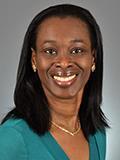 With her distinctive perspective as a general pediatrician at Boston Children’s Hospital and an assistant professor of pediatrics at Harvard Medical School, Inyang Isong, MD, MPH, ScD, is a health services researcher for HSDM Initiative to Integrate Oral Health and Medicine. Her research interests include integrating oral health into pediatric primary care and evaluating multi-level determinants of children's oral health status and access to care.
With her distinctive perspective as a general pediatrician at Boston Children’s Hospital and an assistant professor of pediatrics at Harvard Medical School, Inyang Isong, MD, MPH, ScD, is a health services researcher for HSDM Initiative to Integrate Oral Health and Medicine. Her research interests include integrating oral health into pediatric primary care and evaluating multi-level determinants of children's oral health status and access to care.
Tell us a little bit about your background.
I was born and raised in Nigeria and emigrated to the U.S. after medical school. Interestingly, I had briefly considered going to dental school; my older sister was a dentist, and I was fascinated by the field as a young adult. I ended up choosing medical school, but serendipity drew me back to dentistry years later.
What attracted you to work that prioritizes the integration of oral health and primary care?
After completing my pediatric residency training, I worked for years as a community-based pediatrician in a wonderful inner-city neighborhood on the West Side of Chicago. I learned so much while working there, and a couple of things struck me about the patients I cared for:
- First, their oral health status. At that time, as a pediatrician, examining my patients’ teeth and gums was not within my typical scope of practice. However, I could not help but notice that a large percentage of my patients had LOTS of cavities. I wondered why.
- Second, no one seemed to care. I was struck by the fact that as physicians, our patients’ oral health was not one of our priorities, and we instead focused on “more important” issues like obesity or asthma. We had not been trained to identify and address these oral health related issues, and there were so few available dentists in the area that we could refer to that these problems often remained unaddressed.
A few years later, while pursuing my MPH at the University of North Carolina, I was fortunate to be exposed to the important work being done by a team of oral health researchers who were at the forefront of oral health and primary care integration. One aspect of this work involved training pediatricians to provide fluoride varnish during medical visits and make early referrals to a dental home. This simple approach made sense and got me very excited about oral health and primary care integration. When I subsequently transitioned to a career in health services research, I turned much of my work’s focus on this.
How long have you been collaborating with the Initiative to Integrate Oral Health and Medicine and the Center for Integration of Primary Care and Oral Health (CIPCOH)? Discuss your role.
We have been collaborating for so many years that it’s hard to remember just how many! We have done a lot of important work together over that time, mostly focused on building capacity of primary care providers and medical offices to deliver preventive dental care to patients in a systematic way.
What are some of your current projects that are related to the Initiative and/or CIPCOH?
My current focus is on understanding facilitators and barriers to dental care access among children with special health care needs. We are currently developing an innovative strategy to conduct oral health assessments among children with special health care needs using a telehealth approach.
How has the COVID-19 pandemic highlighted the benefits of working as part of a healthcare team to help break down barriers to care for different populations?
I believe the pandemic exposed fault lines in our healthcare system that have existed for years. It truly highlighted the critical need to break down siloes and work collectively to first build trust with the communities we serve. This paradigm shift in our thinking and approach is essential if we are to effectively dismantle barriers to care for diverse populations. One of the key advantages of working as a cross-disciplinary team to tackle some of these intractable barriers is that each discipline brings a distinct perspective and specialized knowledge that can be harnessed to find innovative solutions and overcome obstacles more effectively.
In your opinion, what does the future of integrated primary care and oral health look like?
We have come a long way over the last couple decades, but there is still much work to be done in eliminating the artificial divide between the two. I envision a healthcare system where oral health is considered an integral part of overall health—one that prioritizes holistic care, effective communication, and patient-centeredness. I am optimistic that we are moving steadily towards the realization of a “Health Home” model, where the existence of siloes becomes obsolete. In this space, patients can receive high-quality healthcare services that are fully integrated, comprehensive, coordinated, and easily accessible.
